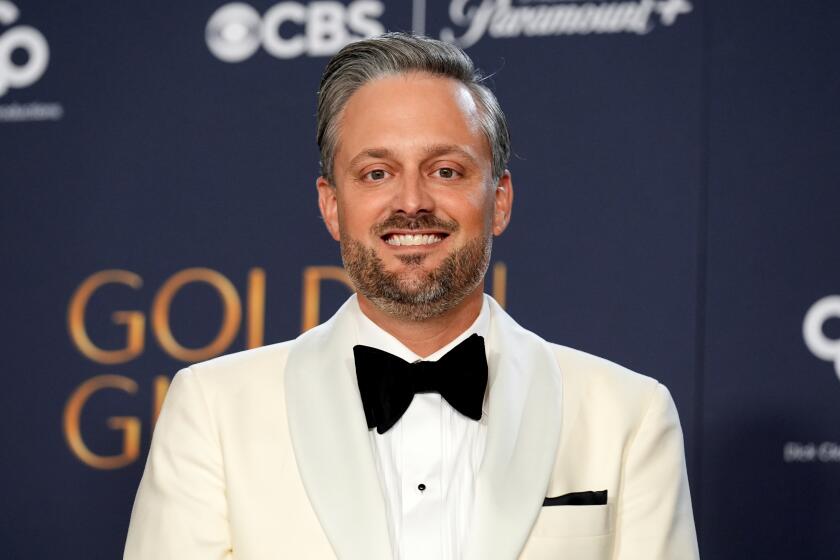Sundance short films can be first steps in successful careers
- Share via
Think of the Sundance Film Festival’s shorts program as a glimpse into the future of movies. In 1994, you could have caught Wes Anderson’s brilliant “Bottle Rocket,” which grew into a full-length feature a couple of years later and was the first step on the road to his current masterwork, “Moonrise Kingdom,” as well as his second screenplay Oscar nomination, this time with Roman Coppola. In 1993, Paul Thomas Anderson’s short “Cigarettes & Coffee” resonated with the singular contemplative voice that would craft “The Master,” with stars Philip Seymour Hoffman, Amy Adams and Joaquin Phoenix up for Oscars as well.
Trevor Groth, director of programming for the festival, knows the crystal-ball aspects of Sundance’s shorts firsthand. He remembers the years both Andersons’ work surfaced in the pile of submissions. It still gives him chills. “Watching, you can feel the future that is going to unfold in front of them,” Groth says. “From the beginning their voices were that distinctive.”
Though you never know how fate, or fickle audiences, will favor them, the shorts filmmakers at Sundance this year are an eclectic international bunch whose work carries with them that sweet sense of discovery. The programming team’s mantra — show us something we’ve never seen before — has resulted in a creative canvas of 65 shorts infused with an irrepressible sense of invention that is infectious to watch.
PHOTOS: Sundance Film Festival 2013 - Dramas in competition
Groth, who began his Sundance career 20 years ago by helping program shorts, will never forget the moment when a studio exec passed along an underground video whose irreverent dark humor and inherent weirdness just spoke to him. Called “The Spirit of Christmas,” it was by a couple of unknowns — Matt Stone and Trey Parker — before “South Park.” Groth tracked down Stone and Parker, nabbed their film for the festival, and says it still stands for him as a classic example of how you can find “the purest of cinema in shorts — there is no need to compromise.”
It’s easy to shortchange shorts as merely stepping stones to the real deal — feature-length films. But just as a short story is not a novel with fewer pages, a short film is its own beast. A great one requires a rigorous discipline in storytelling, masterful editing and a clear understanding of what exactly you are trying to say. An inspired idea doesn’t hurt either.
This is why Groth loves to see established filmmakers like Todd Haynes and Neil LaBute come back to the form again and again. LaBute, for example, is credited with writing three shorts in 2012, directing one, and contributing a segment to last year’s “Stars in Shorts,” which is exactly what the title suggests — all that while working on three feature films in various stages of production.
Whether 2013 will uncover any filmmakers like LaBute, the Andersons or Stone and Parker, it certainly has its share of wonderfully weird shorts.
Among my early favorites is the existential animation piece “Oh Willy…” from Belgium’s Marc James Roels and Emma De Swaef. It unfolds during Willy’s return to his most elemental self, specifically the nudist camp where he was raised. The stuffed-cloth characters, constructed out of what looks to be flesh-colored felt, tell a modern-day story about mortality and the measure of a life. It’s a quirky yet emotional piece about a savage more pudgy than noble, his bumbling indecision remarkably captured in meticulous stop-motion. Two other intriguing animation pieces that caught my eye — “Seraph” and “Thank You” — could not be more different in style or tone. Both take provocative cuts at the ways in which love leaves its mark: a graphically rendered gay teen who carves eyes into everything, including flesh, and a snowman whose heart literally melts for a fire-tinged puppy.
PHOTOS: Sundance 2013 - Premieres
Sundance’s short shorts and long shorts range from a few minutes to nearly 50; the average is closer to 15. With so little time to play with, a filmmaker can’t afford to squander a second, much less a minute. If you need a reminder of how difficult that is to pull off, spend a half-hour on YouTube watching random videos and not moving on until the dog stops jumping, or the cute baby stops laughing. Since digital technology and editing software have put moviemaking into the hands of the masses, it’s almost easier to spot the true artists.
At least that’s the thought that occurred as I was watching the stunning, nontraditional “Primate Cinema: Apes as Family,” one of the festival’s more intriguing entries. A slim 12 minutes from Los Angeles-based mixed-media artist Rachael Mayeri, whose work more frequently turns up in museums around the world, the film is a wildly provocative meta meditation on media, monkeys and humans dressed as monkeys. Essentially a soap opera about the social dynamics of chimpanzees, it was made for chimp consumption and played to the primate inhabitants of Scotland’s Edinburgh Zoo on TVs scattered around their space. It is strangely funny, yet absorbing to watch them watch — and like so many of the shorts, leaves you pondering the implications long after.
That audiences are increasingly open to embracing “six minutes of weird,” as Sundance’s current shorts programmer Jon Korn puts it, is one of the more gratifying shifts he and co-programmer Mike Plante have seen take place. There are fewer “shorts as calling cards” from feature director hopefuls and more making the most of a few minutes in the entries the two personally screened during the selection process this year — roughly 3,000 between them, a record 8,127 submissions in all screened by the team of eight.
Plante believes the democratization and proliferation of digital bits on the Internet have not only empowered more artists but served to whet the appetite and sharpen the aesthetic taste of audiences as well. Sundance’s own democratic process helps, I’m sure — anyone, literally anyone, can submit a short for festival consideration.
Perhaps that is why the surprises of this year stand in such sharp relief. There are wordless triumphs in “On Suffocation” by Swedish filmmaker Jenifer Malmqvist and “Century,” from Ohio-born Kevin Jerome Everson. The chilling “Suffocation” makes its surreal study in a pristine prison inside an unnamed Islamic state where being gay comes with lethal consequences. In complete contrast, “Century,” set in a quintessentially American auto wrecking yard, is a requiem for the discarded told with the exceptional eloquence found in the crushing of auto bodies.
There are narrative treatises on the difficulties of coming of age — such as the question of abortion in “Magnesium” and deflowering in “Social Butterfly.” But it is an exceptional examination of power and provocation in the hands of children who spot a tryst in “The Curse” that rocked me in the way Michael Haneke’s very different thematic take, “The White Ribbon,” did some years ago. “Curse” comes into the festival with a win from Cannes already in hand.
And then there are the documentaries, typically the longest of the shorts, often close to the 50-minute cutoff. Among the standouts is “Outlawed in Pakistan,” tracing one girl’s fight against the rape that brought her, not her attackers, a death sentence by tribal elders. From filmmakers Habiba Nosheen and Hilke Schellman, it is a story of courage wrought in tears, persistence etched in pain.
If anything, the general mood that runs through many of the films is one of reckoning and the many ways in which social conventions define, destroy and, at times, empower. In the documentary “Fall to Grace,” filmmaker Alexandra Pelosi picks up former New Jersey Gov. Jim McGreevey’s story after the married politician publicly came out, resigned and divorced. The conversations are provocative even as they swing between the serious and the absurd, like the literally and metaphorically explosive silliness of the end-of-days “The Apocalypse,” characterized by director Andrew Zuchero’s countless small, smart choices.
The shorts are, quite simply, seductive; even the ones that don’t hit all the right notes are intriguing. As Korn says, “It’s great to see something on its way to being something special.”
MORE SUNDANCE COVERAGE
VIDEO: A video guide to Sundance 2013
More to Read
From the Oscars to the Emmys.
Get the Envelope newsletter for exclusive awards season coverage, behind-the-scenes stories from the Envelope podcast and columnist Glenn Whipp’s must-read analysis.
You may occasionally receive promotional content from the Los Angeles Times.







